Star Date: May 2007
The Kingdom of Cambodia
Hello Dear Family & Friends!
“Sua s’dei!
(Good day -Cambodian Khmer)
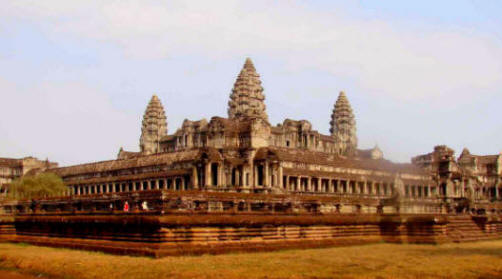
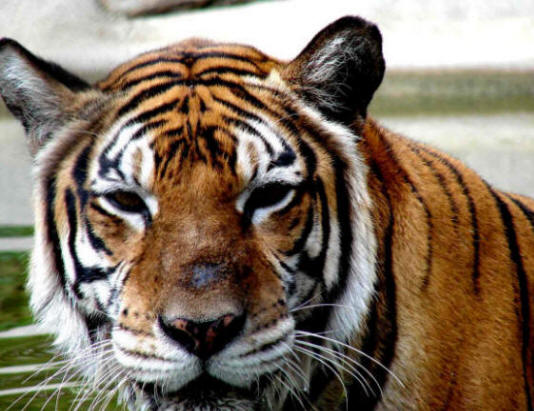
A magnificent wild tiger rescued from poachers.
“Is not life a hundred times too short – to get bored?”
Friedrich Nietzsche
Love at first sight. The daughter of the Dragon King was paddling in a boat when a ship carrying an Indian Brahman sailed by. Kaudinya, bedazzled by the beauty of the princess shot an enchanted arrow from his bow, making the shy princess agree to marriage. The father, unable to come up with a proper dowry, drank up all the lakes and waterways from his kingdom and presented the remaining land to Kaudinya to rule. This new kingdom was called Kambuja. This story points out the close historical ties, culturally and religiously, that Kambuja has had with its giant neighbor to the west, India.
This exotic land lived in peace from the beginning and eventually was ruled by the vast Angkor empire (5th to 13th century) which encompassed much of present day SE Asia.* The building of Angkor Wat, was the pinnacle of their civilization, but the drain on the kingdom’s resources weakened their rule in the outlying areas. The Thais, who had migrated down from Yunnan, China to escape the Wrath of Khan, Kublai Khan that is, had gathered strength and attacked Angkor Wat repeatedly. They finally succeeded in 1431, making off with treasures, intellectuals, artisans and even dancers, bringing them back to their royal court in Ayuthaya. The Khmers retreated to the present capitol site of Phnom Penh. A succession of weak kings were cast about on the waves from neighboring Thailand and Vietnam until 1864 when French gunboats forced King Norodom into signing a treaty of protection. Like a side hobby to their rule in neighboring Vietnam, the French were never interested in developing infrastructure and after 70 years of rule they had established only one high school in the whole country. They did, however, trade the Thais parts of Laos for occupied areas in the north, returning Angkor Wat to Cambodia for the first time in over 100 years.

The enormous, haunting faces at Bayon Temple in Angkor Thum represent Buddha and King Jayavarman. Although a Buddhist temple, you can see it was modeled after the great Hindu temple complex of Angkor Wat.
Following WWII the French were liberated in Europe but they refused to allow the same for their colonies. King Sihanouk, the ultimate political chameleon, helped to orchestrate his country’s independence in 1955 and ruled the new, ‘free’ Kampuchea until imprisoned by the Khmer Rouge in 1975. He triumphantly returned from exile in Beijing, in 1989, and this survivor of the tides of time was finally forced to abdicate in 2004. Almost 50 years of tumultuous rule came to an end and his son, Prince Sihamoni, took the throne. Struggling to bring Cambodia into the modern world, amid political tension and rampant corruption, King Sihamoni is the last in the long line of Angkor’s god-kings.
In 1970, US and South Vietnamese forces invaded Cambodia in an effort to flush out thousands of Viet Cong. Four years of carpet bombing in the east by US B- 52 bombers devastated the country and left an estimated 250,000 Cambodians dead. Several hundreds of thousands died in this conflict between 1970 and 1975 and the stage was set for Paris-educated Pol Pot to march into Phnom Penh in April 1975. From then, until liberated by Vietnam in 1979, this brief dark chapter turned back Cambodia’s clock to ‘Zero’. As one of the bloodiest, most ruthless genocides in recent history it witnessed the almost total annihilation of an ancient culture, the existing economy and the deaths of between 1 and 2 million Cambodians from disease, malnutrition, and outright murder. In a nondescript high school in the suburbs of Phnom Penh alone, following documented gruesome torture, over 17,000 men, women, and children were clubbed to death or shot and thrown into mass graves at various ‘killing fields’ nearby. Pol Pot’s insanity to cleanse the country saw ‘enemy’ intellectual factions in governmental, religious and business sectors exterminated and he eventually turned his guns on the North Vietnamese troops who had trained his young army. He even wiped out the executioners who carried out his killing sprees. How can modern man, with all the available knowledge and technology be led into such desperate times? Can it be prevented in the future? Possibly the growing fear that is permeating modern society needs to be offset by integrity and compassion, in whatever form it takes.

The ‘heart chamber’ hidden deep within Ta Phrom Temple. The massive trees of the jungle have reclaimed much of this mysterious complex.
The people of Cambodia are just now recovering. With the withdrawal of Vietnamese troops in 1989 and the death of Pol Pot in 1998, Khmer Rouge supporters still surface in recent elections. We were in Phnom Penh for the April 1st election of the white hats versus the yellow shirts. As everywhere, it is a joke when listening to the loud but hollow campaign promises. As with most governments of the world the power remains the same – only the names or parties change. What will it take for Cambodians to once again trust their leaders? Likewise, what would it take for the west to once again really believe our politicians? Where do you stand? Maybe it is just easier to give up, as so many have, and ignore what is going on around us. As Benjamin Franklin said, “All it takes is for enough good men to do nothing…….” Amazingly these unassuming Khmers have survived years of brutal war, cruelty, and poverty; yet their smiles have endured. These gentle people leave a lasting impression on anyone who visits their kingdom.
A long boat trip down the Mekong River and backwaters from Vietnam gave us a further taste of life on the river. We walked across a dusty border crossing and once on our new Cambodian boat we couldn’t even tell we had entered a new country, as lives along the river blended together. Tiny hand woven shacks on stilts were bursting at the seams with kids of all ages waving, smiling and yelling “Hello!” Out front little naked brown bodies splashed and giggled in the river. Fish was drying, boats and nets were being repaired, and food was cooking over wood fires.
Loaded onto buses we arrived after dark in Phnom Penh. In the budget area by Lake Boeng Kat Joseph arranged for the only decent room in a basic but quiet guesthouse. Many places were quite dilapidated, as most backpackers congregate in one area and rate the social scene above comfort. Slum conditions are hidden by the throbbing boom, boom of the music until all hours. The upside is an infrastructure full of cheap restaurants and internet. After a refreshing shower we had our fill of Indian food, all you could eat for $2. Nothing like some curry and fresh garlic naan to finish off a long day. Talking to a diamond cutter from Madurai, India, Joseph reminisced about his days in business, flying around the world in search of the best gems available. No one would have guessed, looking at us with our simple gold wedding bands and travel clothes, that he has dealt with some of the most influential people and the rarest gems in the world.
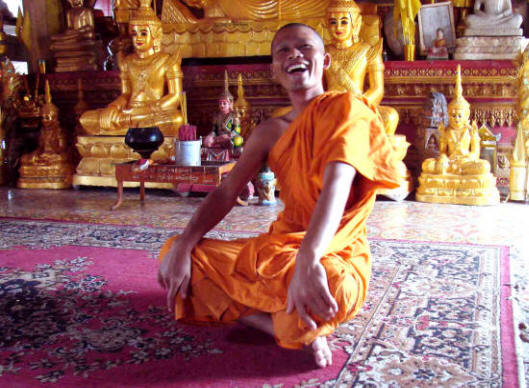
A full body laugh!! We enjoyed so many pleasant hours
visiting with the friendly Buddhist monks.
Wandering into ‘wats’ or temples we were greeted by one friendly monk after another. A 29 year old monk invited us to sit down on a mat in front of the alter and chat. He said we felt like his parents. He was brought to the wat as a baby after his parents were killed, and raised by the monks. A monk without a past and an uncertain future. Another wat found us again sharing a woven mat and a coconut with 2 young monks in front of Buddha. We offered to also buy them a coconut but they explained how they must go out in the morning to ‘beg’ for food or receive alms, allowed to eat only until noon, after which time they can only drink. With over 60,000 monks hanging out at the local neighborhood wats in Cambodia it must get a bit much making sure they are all fed. In Vietnam the government requires that the monks raise their own rice. Not a bad idea. Communing with the land would certainly help them connect and meditate, as any serious gardener realizes. We spent over 2 hours talking English and their language skills were so good we even discussed spiritual ideas. With 2-3 hours a day of meditation and a simple diet they seemed light and clear in mind & body and were a pleasure to spend time with. Before we left the teacher of English asked for some help with the perplexing phrases he had recorded in the text messages on his cell phone. High tech hits the wat! After an impromptu half hour mini lesson he invited us to join him to visit his village near Kompong Cham. We were appreciative but declined. Had we more time on our visa we may have gone down his bumpy dirt road for a closer look at rural life near the rubber plantations. Next time.
All the splendor of the Royal Palace is in stark contrast to the nearby desperate beggars with limbs missing due to landmines. We were surprised to read that just as many Cambodians are amputees due to snake bites. They go to the local medicine man for treatment and the ensuing infection leads to amputation. Either way is inconceivable. An oblivious beggar family of four forgot their worries as they frolicked in the spray of the sprinklers on the grass. Without assistance from the government these poor folks must rely on one of the many N.G.O.’s or non governmental organizations doing praiseworthy work in Cambodia. As previously mentioned, we don’t encourage begging by giving money. Instead answer them a sincere hello in their language and smile. Share food, buy from local markets, cooperatives or training centers, or donate to a thoroughly researched aid organization. Volunteer or offer assistance with the aim to strengthen the positive momentum in a country, such as education or environmental projects. Be creative. There are so many ways to interact with the locals of a country while helping them. If one is sincere and gives from the heart, the rewards come flooding back.

Elephants never forget. Joseph gave this sociable character a banana from
our bag and 2 hours and over a mile later, while giving a tourist a ride, she
spotted us crossing the road. She refused to budge until we walked over
and once again produced a magic banana.
Strolling along the riverside promenade, gazing at the distant crumbling French colonial buildings and fine restaurants, one can imagine how Phnom Penh was formerly called the ‘Pearl of Asia’. The similarity ended there. Taking the long way home we watched as vendors at the nearby market hawked their wares and whipped up treats of all descriptions from fresh fruit smoothies, to tapioca & coconut desserts, to barbequed skewers of mystery meat. Indescribable or weird items may include: spiders and insects of all shapes, duck fetus, field mice, king cobra, grubs, snouts, tails, ears, innards and ‘outards’ of anything that moves, etc. Like in similarly poor Laos, if it will sustain the body you may find it on a plate or skewer. Soups on!
Angkor Wat is truly one of the world’s great remaining treasures. The largest religious temple in the world, it certainly rivals the Taj Mahal, Macchu Picchu, or Notre Dame. How does one begin to describe the awe inspired while gazing down from the 10 story high towers of Angkor Wat or the power felt while staring at one of the over 200 colossal, haunting stone faces of Bayon? Now only 6 hours north, on a newly paved road (or a short flight away), the secret is out. Joseph had visited here in 1960 on a once in a lifetime experience with his Mother. Gone are most of the jungle forests and the wild elephants have been replaced by trained ones but some the mischievous monkeys have survived. War and treasure hunters have taken their toll on this magnificent monument but renovation work desperately tries to catch the stone blocks before they crumble further, as workers attempt to rebuild and recapture the grandeur of ancient times. The second time visiting for each of us we spent a full sunrise to sunset day exploring these wonders. The trick seems to be missing the peak tourist times, (as in all popular destinations) and going counter clockwise to the tour buses. Arriving just after the sunrise crowds cleared out, we literally had Angkor Wat to ourselves. Choosing more remote temple ruins between the main sites we also were able to avoid the inevitable glut of tourists and hide away in the jungle, imagining life in ancient times. In a ‘tug of war’ the jungle quickly fills all voids and regains control of areas formerly commandeered by the advancement of man. Massive roots seem to be swallowing the temples of Ta Prohm and these remains, site of the movie “Tomb Raiders”, sends one spinning into another reality. As we sat having our salad amongst the ruins, we remembered our previous visits. In the 1960’s the jungle in fact owned most of the temple, while as recent as 1999, I was completely by myself in this maze. When obviously lost and a little scared I stumbled onto an inner courtyard where a tiny feeble guardian of the shrine carefully swept away any fallen leaves. All fear dissolved as he led me into one of the 4 vertical towers and like a dream now, we put our backs against the wall and pounded our chests, mimicking the beating of our hearts. Boom, Boom! Boom, Boom! The whole chamber loudly resounded in an uncanny, overwhelming echo, permeating our very souls. I sat down with him for a long time afterwards, absorbing the essence; transported in time. As the late afternoon shadows grew, I awoke, leaving a vivid memory that I feel to this day. Guiding me back to the entrance arch this humble, ethereal guardian vanished as quickly as he had appeared.

This golden gibbon monkey at the Pnom Tamao Wildlife Sanctuary started howling loudly. Distracted, his black gibbon buddy (below) grabbed my leg and wouldn’t let go. Their arms are nearly twice as long as their bodies and they can get into all sorts of mischief.
Not quite traveling by elephant, as in pre twentieth century fashion, we unknowingly were about to yet again sample a taste of travel of yesteryear; before smooth roads and fast vehicles. As our chariot arrived, an open pick up truck, we questioned whether it was possible to cram more bodies aboard, with 12 victims already clinging precariously. The promised 5 hour express boat to Battambang, for which we paid extra, appeared as our jaws dropped. We were loaded onto one of the roughest boats we had ever laid eyes on and putt putt, smoke, cough, roar we were off across Tonle Sap Lake. It was interesting to see the life of the fishermen, complete with all types of fish traps and nets; some small throw types, some large 30 ft triangular nets with counter balances to raise & lower them, others just haphazardly set up in hopes of catching an unsuspecting fish passing by. Mile after mile of nets surely must cut down the fish population, especially since every single net we have watched being pulled in was lucky to have a few small wriggling fish in it. It was common to see one of the large migrating birds, storks or herons, perched atop a net waiting for some easy lunch. Off we sped towards the middle of the lake when clunk, grind we coasted to a halt. While bobbing around, the crew started tearing up the front boards and dragged out a new propeller. Fifteen minutes later we were once again on our way. Several times there was an awful grinding sound as our new propeller got entangled in floating nets and had to be freed by a deckhand with superb balance and an array of knives and hacksaws. The journey down the river toward Battambang was stimulating as we passed through one floating village after another. Each colorful cluster had everything in it but noisy trucks and motos. Floating churches, mosques, temples, houses of every description, stores, schools, government offices, gas stations and restaurants; punctuated with small boats selling everything from hair cuts and beauty supplies, to fresh fruits and vegetables, or snacks prepared on deck over a wood fire. You name it, it was there. Friendly waves, hellos and splashing slippery brown kids bobbing in the wake filled in every open space. Such a colorful ruckus. It was fun to just surreptitiously watch it happen as we passed through the middle of it. The Cambodians here, many of them from Vietnam, have started to finally relax. This area was the last stronghold of the Khmer Rouge and as late as 1998 saw conflict and murders of villagers. When I went through in 1999 on the way to Bangkok it was not uncommon to still see someone sitting on their houseboat with an AK-47 laid across their lap. Possibly these war weary locals are breathing a little easier, or so their friendly smiles suggested.
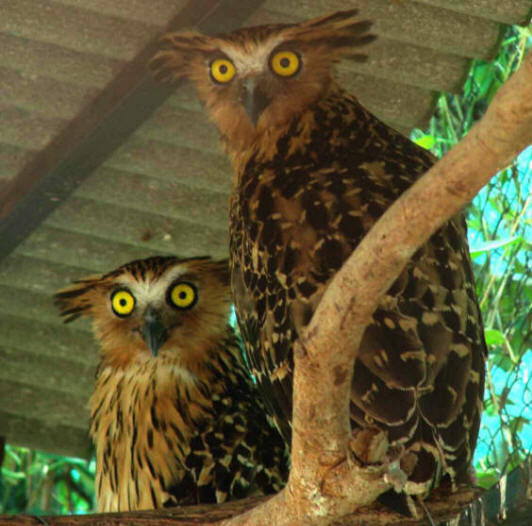
Sleeping when we arrived, we started quietly talking to these fellows. Interested, their eyes popped open and instead of moving the owl on the right screwed his head all the way around, Exorcist- style, to catch a look.
The row of houses and buildings along the shore were raised way up to 30 feet in the air in places, stork like, waiting for the coming monsoon rains to make them waterfront property once again. Of course the village in front of them just rides out the rising water on their bamboo floats. As we continued through one floating village after another we heard a bang as smoke and flames came out of the overheated engine. Black smoke pouring out we slowly limped up to a quaint floating tea house, coasting in the last 20 feet. We had to balance our bags as we stepped off the pitching boat, onto the rocking tea house, and out back across long thin teetering bamboo gangplanks to the muddy shore. We were then loaded, overflowing, onto the backs of 2 small pickups, over 20 in each cab and back (with the addition of all the locals on their way into Cambodia’s 2nd largest city). It was by far the muddiest, dustiest, roughest ride to date. And if the jarring to our spines and butts wasn’t enough, everyone would make a wild dive down to avoid overhanging branches with thorns. I still have the mark as one tore across my shoulder. We arrived in Battambang 2 hours later, well toasted and dust coated; wanting to wring the neck of the conniving boat agent who knew the truth but promised that this express boat still went all the way to Battambang. Oh well. We are in search of adventure and that it was! Just be wary of boat rides at the end of the dry season. With all resources in this poor nation used for war in recent decades, only a few new roads exist in Cambodia and once off the paved route be prepared for bumpy, dusty or muddy trails, that even few buses attempt.
Our goal of hanging out with locals could just as easily be met by heading south to the cooler climes of Kep, Kamput and Sihanoukville, along the coast. Finally landing at Serendipity Beach, we felt we had arrived. A big vibrant central market, long daily excursions along the ocean, and colorful sunsets while drinking fresh coconuts and melting in lounge chairs along the beach, shakes off the dust, soothes the soul and prepares us for the next chapter.
And so it goes………………………………………………….. Next the Philippines. We send our love to you and thank you for your emails and feedback. Glad you are enjoying our crazy adventures. Make sure the word ‘bored’ is deleted from your vocabulary. There are simply too many things to do, subjects to learn about, places to go and people to meet. Besides if you do find yourself ‘bored’ you can always have a look at this webpage and plan your next adventure – beats reruns on TV! Until next month Take Care and Keep in Touch.

When tired – sleep!
Love, xoxoox Nancy & Joseph
Travel notes:
$1.00US = 4,000 Riel (but US dollars are used just as much.)
* As previously explained, most of our information is obtained from Encarta Reference Suite, Britannica Encyclopedia, The Lonely Planet travel guides, notes from brochures and museums, talking to people, etc.
Phnom Penh:
Lake area: Number 9 Sister Guesthouse. Street 93, Boeng Kak, Telephone: 012 42 42 40. Room #1 is right on the lake and quiet ($6). If it isn’t available forget the other rooms and keep looking.
Royal Palace: We escaped the blazing mid day sun inside the impressive National Museum. With comprehensive historical displays radiating from the central garden, we had fun comparing symbolism from other countries with the Khmer culture. One of our favorite displays was a room full of Buddhas of every shape and posture, each sporting a different hairdo or expression. One for every occasion. The nearby Royal Palace and Silver Pagoda, with its must see temples and grounds, is also a memorable place to spend several hours.
Sovanna Phum: Cambodia has a rich and long tradition of performing arts: folk and classical music & dance, shadow puppetry, mask theatre, and circus. Sovanna Phum, meaning Golden Era, is reviving and supporting the arts and offers low key yet professional performances on the weekends, with proceeds going back to educational and prevention programs for underprivileged. Treat yourself, while helping these hard working Cambodians. (023) 987 564
Phnom Tamao Wildlife Sanctuary: The environment is always a concern in developing countries and a visit to the Phnom Tamao Wildlife Sanctuary encourages protection of the tantalizing but almost extinct wildlife of Cambodia. We took a ‘touk, touk’ to the surprisingly well constructed compound and were treated to lions, sun bears, tigers, large water birds, owls, pythons, monkeys, buffalos, river otters, and elephants all rescued from poachers. Highlights were the gibbons howling ‘whoop whoop’ while their crafty buddy grabbed my leg and wouldn’t let go; and our perseverance which allowed us to observe an enormous, magnificent tiger lazily soaking in the water following his mid day nap. Conditions in zoos are definitely improving in Asia. If you like animals this is worth a look and another good cause.
Follow NH2 37KM south from Phnom , then 6KM down a sandy track.
Book through Malaya Travel, 023 986 396, lake area, ‘Touk touk’ to Tamao Mountain, $15.00 whole day, including stop along the river, if your butt can handle any additional miles!
Siem Reap/Angkor Wat:
With the tourist boom this is a little more expensive city but lots of good guesthouses down the side streets. Explore the ruins, $10 a day while being pulled in a covered hooded carriage behind a motorcycle, ‘remorque-moto’. Say hi to our warm, honest driver, Mr. Yon, (855) 92 277 140. He is studying to become a guide and his English is improving. We gave this forward thinking young man a couple extra dollars towards his guide license. Skip the sunset on the hill unless you are a herd animal. Possibly catch the changing hues on Angkor Wat or Bayon.
Battambang:
Holiday Guesthouse, around the corner, down the alley from the Royal Hotel. Clean, new, $6 a night. Telephone: 012 647 648. No English spoken but the Royal Hotel can answer questions. We have discovered that when it is hot, never stay on the top floor but rather one floor down as it’s cooler.
Sihanoukville:
Diamond Beach Guesthouse: Street Lion 2, Serendipity Beach, Telephone: 016 494 908 (Next to the New Sea View Villa) Cheap, quaint (#5, $6) In the heart of the action, only 100 ft from the beach, but hidden from the night time music, earplugs do the trick. Places right on the beach start at $12. Otres Beach is the place for a quiet getaway.
Our chair is still warm at the Moon Shack; have a sunset coconut on us. Their vegetable Khmer curry or ‘amok’ is delicious.

Our route around Cambodia for a month.

We had fun playing with these kids in an extremely poor rural village.
Instead of complaining they smile the warmest, genuine smiles.

Anyone for a clay pot? Seen all over Cambodia, these fired pots and charcoal barbeques are used in every kitchen.
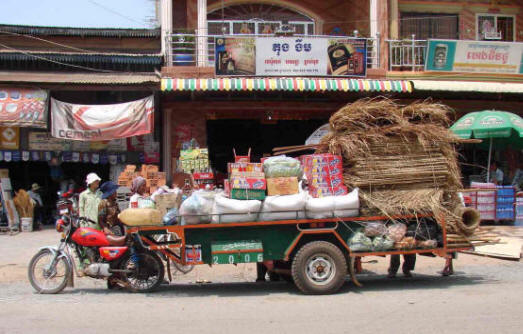
Only partially loaded, all these acquisitions from the market will be pulled by ONE motorcycle to a neighboring village! Once loaded all the shoppers pile on top. We saw some unbelievable loads but catching them with the camera is another matter. Certainly makes better use of our earth’s resources than one person driving around a city in a big gas guzzling SUV.

